#indigenous plant
Explore tagged Tumblr posts
Text
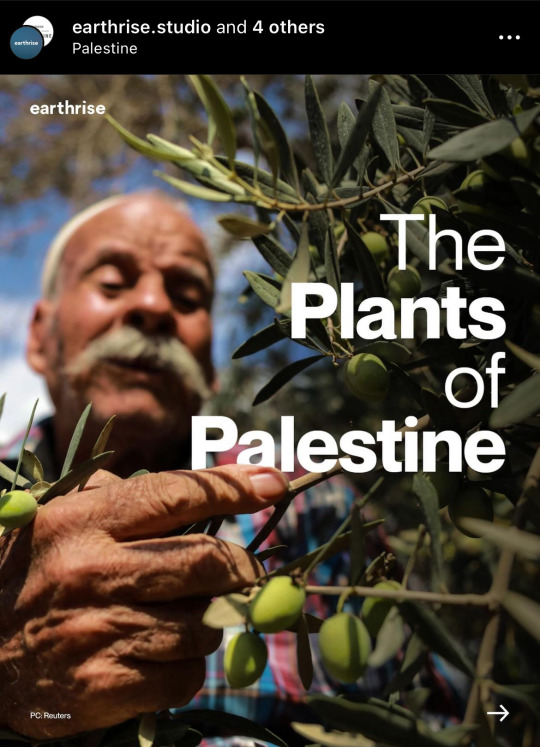


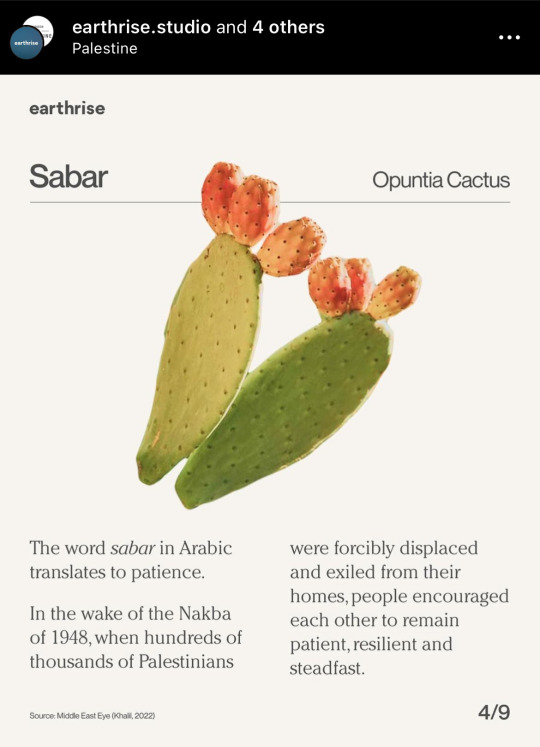
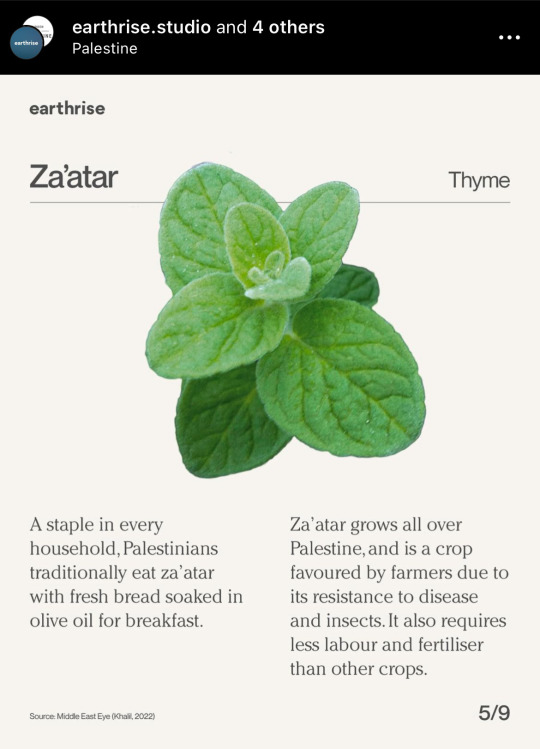
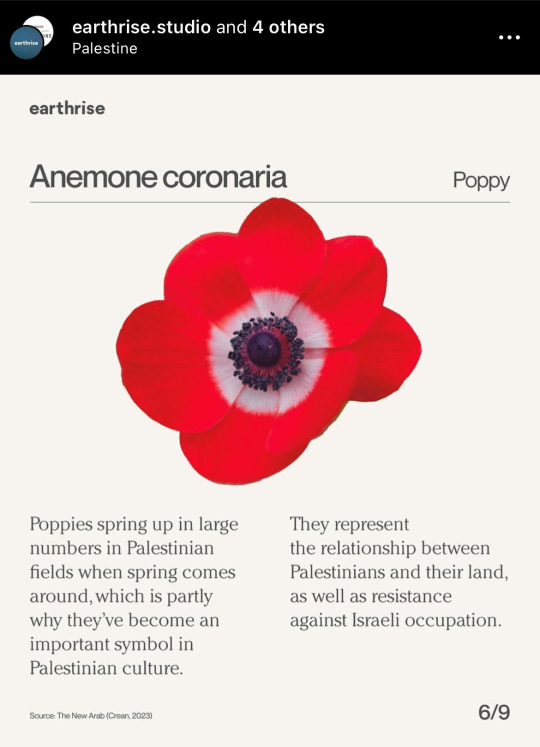

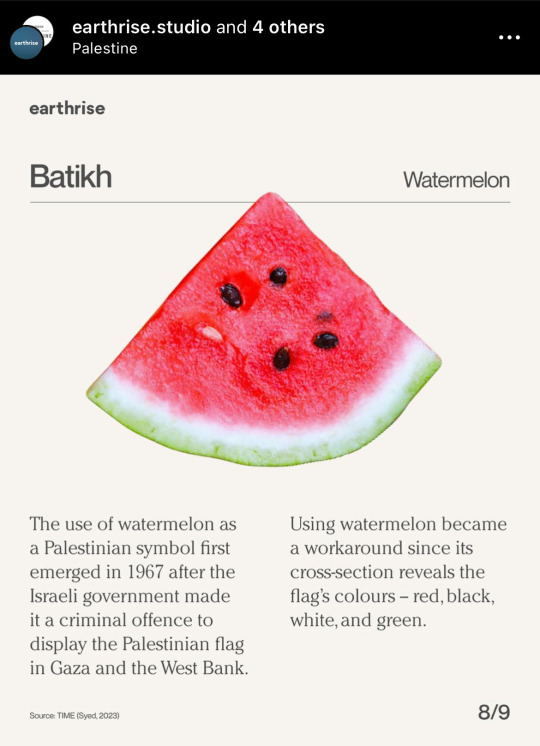
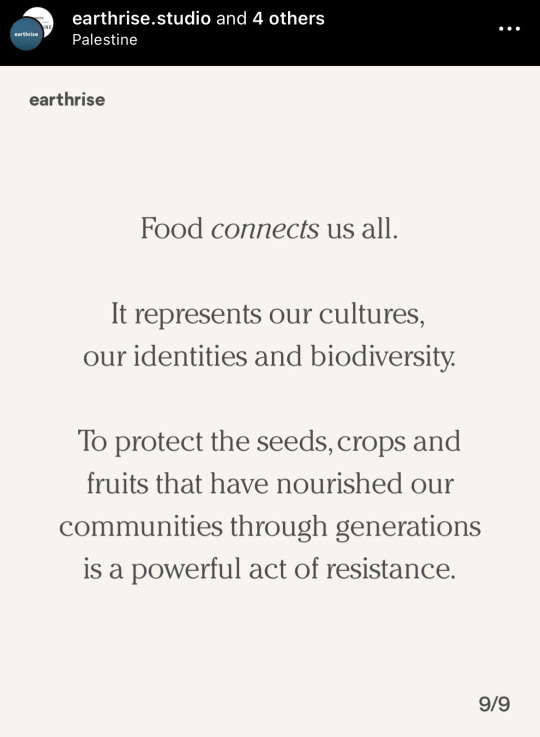
#free palestine#palestine#plants#biodiversity#environment#intersectional environmentalism#gaza#west bank#indigenous#resistance
13K notes
·
View notes
Text
Masterpost: Reasons I firmly believe we will beat climate change
Posts are in reverse chronological order (by post date, not article date), mostly taken from my "climate change" tag, which I went through all the way back to the literal beginning of my blog. Will update periodically.
Especially big deal articles/posts are in bold.
Big picture:
Mature trees offer hope in world of rising emissions (x)
Spying from space: How satellites can help identify and rein in a potent climate pollutant (x)
Good news: Tiny urban green spaces can cool cities and save lives (x)
Conservation and economic development go hand in hand, more often than expected (x)
The exponential growth of solar power will change the world (x)
Sun Machines: Solar, an energy that gets cheaper and cheaper, is going to be huge (x)
Wealthy nations finally deliver promised climate aid, as calls for more equitable funding for poor countries grow (x)
For Earth Day 2024, experts are spreading optimism – not doom. Here's why. (x)
Opinion: I’m a Climate Scientist. I’m Not Screaming Into the Void Anymore. (x)
The World’s Forests Are Doing Much Better Than We Think (x)
‘Staggering’ green growth gives hope for 1.5C, says global energy chief (x)
Beyond Catastrophe: A New Climate Reality Is Coming Into View (x)
Young Forests Capture Carbon Quicker than Previously Thought (x)
Yes, climate change can be beaten by 2050. Here's how. (x)
Soil improvements could keep planet within 1.5C heating target, research shows (x)
The global treaty to save the ozone layer has also slowed Arctic ice melt (x)
The doomers are wrong about humanity’s future — and its past (x)
Scientists Find Methane is Actually Offsetting 30% of its Own Heating Effect on Planet (x)
Are debt-for-climate swaps finally taking off? (x)
High seas treaty: historic deal to protect international waters finally reached at UN (x)
How Could Positive ‘Tipping Points’ Accelerate Climate Action? (x)
Specific examples:
Environmental Campaigners Celebrate As Labour Ends Tory Ban On New Onshore Wind Projects (x)
Private firms are driving a revolution in solar power in Africa (x)
How the small Pacific island nation of Vanuatu drastically cut plastic pollution (x)
Rewilding sites have seen 400% increase in jobs since 2008, research finds [Scotland] (x)
The American Climate Corps take flight, with most jobs based in the West (x)
Waste Heat Generated from Electronics to Warm Finnish City in Winter Thanks to Groundbreaking Thermal Energy Project (x)
Climate protection is now a human right — and lawsuits will follow [European Union] (x)
A new EU ecocide law ‘marks the end of impunity for environmental criminals’ (x)
Solar hits a renewable energy milestone not seen since WWII [United States] (x)
These are the climate grannies. They’ll do whatever it takes to protect their grandchildren. [United States and Native American Nations] (x)
Century of Tree Planting Stalls the Warming Effects in the Eastern United States, Says Study (x)
Chart: Wind and solar are closing in on fossil fuels in the EU (x)
UK use of gas and coal for electricity at lowest since 1957, figures show (x)
Countries That Generate 100% Renewable Energy Electricity (x)
Indigenous advocacy leads to largest dam removal project in US history [United States and Native American Nations] (x)
India’s clean energy transition is rapidly underway, benefiting the entire world (x)
China is set to shatter its wind and solar target five years early, new report finds (x)
��Game changing’: spate of US lawsuits calls big oil to account for climate crisis (x)
Largest-ever data set collection shows how coral reefs can survive climate change (x)
The Biggest Climate Bill of Your Life - But What Does It DO? [United States] (x)
Good Climate News: Headline Roundup April 1st through April 15th, 2023 (x)
How agroforestry can restore degraded lands and provide income in the Amazon (x) [Brazil]
Loss of Climate-Crucial Mangrove Forests Has Slowed to Near-Negligable Amount Worldwide, Report Hails (x)
Agroecology schools help communities restore degraded land in Guatemala (x)
Climate adaptation:
Solar-powered generators pull clean drinking water 'from thin air,' aiding communities in need: 'It transforms lives' (x)
‘Sponge’ Cities Combat Urban Flooding by Letting Nature Do the Work [China] (x)
Indian Engineers Tackle Water Shortages with Star Wars Tech in Kerala (x)
A green roof or rooftop solar? You can combine them in a biosolar roof — boosting both biodiversity and power output (x)
Global death tolls from natural disasters have actually plummeted over the last century (x)
Los Angeles Just Proved How Spongy a City Can Be (x)
This city turns sewage into drinking water in 24 hours. The concept is catching on [Namibia] (x)
Plants teach their offspring how to adapt to climate change, scientists find (x)
Resurrecting Climate-Resilient Rice in India (x)
Edit 1/12/25: Yes, I know a bunch of the links disappeared. I'll try to fix that when I get the chance. In the meantime, read all the other stuff!!
Other Masterposts:
Going carbon negative and how we're going to fix global heating (x)
#climate change#climate crisis#climate action#climate emergency#climate anxiety#climate solutions#fossil fuels#pollution#carbon emissions#solar power#wind power#trees#forests#tree planting#biodiversity#natural disasters#renewables#renewable electricity#united states#china#india#indigenous nations#european union#plant biology#brazil#uk#vanuatu#scotland#england#methane
2K notes
·
View notes
Text
so I found this really cool website that sells native seeds- and you might be asking me "snekdood, haven't you posted an entire list of websites that sell native wildflower seeds that you're going to add on to soon?" and yes that's true, but that's not the kind of native seed im talking about rn.
see, on my quest to find websites that sell native wildflowers, I came across this dope ass website that sells seeds that have been farmed and harvested by ntv people traditionally, i'll let the website do the talking:



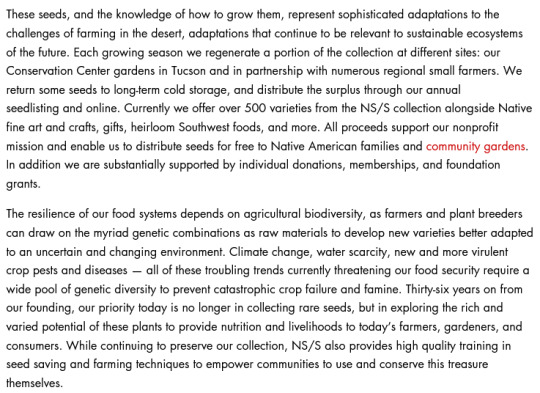
so anyways this is the coolest website ever. you can find the wild relatives of chiles on here called chiltepines, you can find different colors of corn and cool squash's, and every seed from whichever farm has it's own lil origin story written about it. you can also find other veggies here that are already commercially available to help fund and support this organization. as well as there being a cool gift shop with a lot of art made by different native folk from all around as well as cookbooks, jewelry, pottery, weavings, and clearly plenty more:

as well as a pantry?? with premade soup mixes??? and i really want to try them now??????
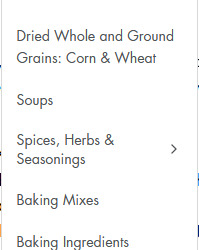
anyways I think its worth snoopin' around bc I'm almost positive you'll see something you think is cool (oh also if you happen to have some seeds passed down from ur family too and ur also native they seem like they would gladly help produce more)
#heirloom seeds#native plants#native wildflowers#native seeds#native seeds search#gardening#farming#seed conservation#heirloom vegetables#vegetables#crops#food#native american#native american traditions#native american heirloom seeds#support indigenous people#indigenous art
4K notes
·
View notes
Text
Dandelion News - November 22-28
Like these weekly compilations? Tip me at $kaybarr1735 or check out my Dandelion Doodles!
1. Los Angeles becomes a sanctuary city for LGBTQ+ youth and immigrants as officials reject Project 2025

“The Los Angeles City Council voted unanimously Tuesday to pass the “sanctuary city” ordinance, shielding queer youth who travel to the city to receive gender-affirming care from prosecution, as well as preventing city resources from being used in immigration enforcement[….]”
2. Huge deforested areas in the tropics could regenerate naturally, study finds

“Cleared or degraded tropical forests around the world covering a combined area larger than Saudi Arabia could regrow on its own, according to new research published Oct. 30 in the journal Nature. [… T]he permanence of regrown forests is critically important to the benefits it can provide to biodiversity and the climate.”
3. Minnesota tribe could soon get a solar-powered resilience hub

“A pair of developers are working to build a microgrid at an elementary school and community center on the White Earth Reservation in northern Minnesota [… which would] provide about 12 hours worth of backup power for residents to be able to charge cell phones, power medical equipment, or stay warm in the event of a power outage.”
4. An exchange between Indonesia and Tanzania supports food security and ocean health
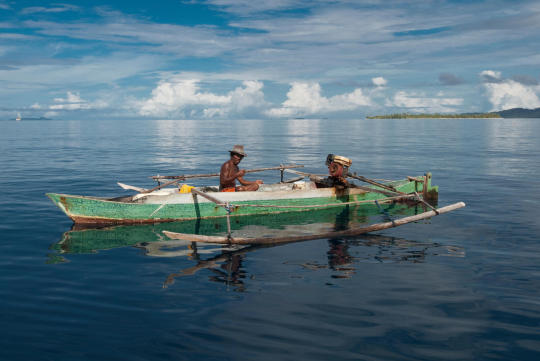
“Around the world, WWF helps manage […] both traditional sustainability-oriented management and science-based practices. This combination supports long-term food security and biodiversity goals. […] Local ownership and management are […] key to achieving stable fisheries and social and economic benefits.”
5. Spiky blue devils and chocolate lilies: Victorian grassland bursts with wildflowers after ecological ‘reset’

“About 70 native plant species could be found within the site, including […] four endangered species of orchid. […] Careful management, including an ecological burn in May and weed control measures to reduce pasture grasses, laid the groundwork for wildflowers to thrive.”
6. Vast forests, wetlands and lakes conserved [in Ontario]

“A vast 970-hectare area featuring thriving forests, wetlands and crystal-clear lakes northeast of Sault Ste. Marie is now protected[….] The intact forests, lakes, wetlands and shorelines support high biodiversity and are home to many threatened species[….]”
7. A New Era of Compassion: How Suncoast Humane Society is Changing Animal Welfare for Good
“Our campus includes outdoor play areas, trails, and even a small swimming pool to encourage animals to stay active, explore, and simply be themselves.”
8. Building climate resilient cocoa farming in West Africa
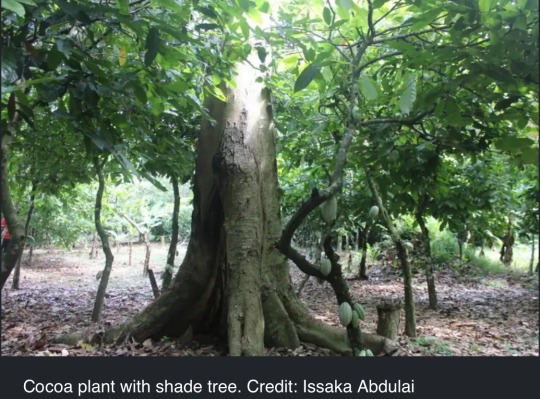
“[… A] promising new approach to improve climate resilience in cocoa agroforestry across West Africa […] focuses on the critical role of leaf "phenology"—the seasonal changes in leaf cycles—in trees providing shade in managing climate impacts. [… S]hade trees that lose their leaves entirely during the dry season proved especially beneficial in maintaining soil moisture[….]”
9. New Zealanders save more than 30 stranded whales by lifting them on sheets

“[The Department of Conservation] praised as “incredible” the efforts made by hundreds of people to help save the foundering pod. “It’s amazing to witness the genuine care and compassion people have shown toward these magnificent animals[….]””
10. 'A really sobering moment:' English zoo fights extinction of freshwater Boxer pupfish

“Whipsnade Zoo aquarists were recently told by conservation partners that that the world's last remaining Boxer pupfish was in their care, prompting the zoo to carry out the immediate transport of all the "precious" Boxer pupfish eggs to another local conservation and education charity in the name of species preservation.”
November 15-21 news here | (all credit for images and written material can be found at the source linked; I don’t claim credit for anything but curating.)
#hopepunk#good news#los angeles#us politics#lgbt+#immigrants#deforestation#nature#minnesota#native american#indigenous#electricity#solar panels#solar energy#solar power#ocean#fishing#food insecurity#wildflowers#native wildflowers#native plants#conservation#canada#animal shelters#humane society#agroforestry#new zealand#whale#fish#endangered
126 notes
·
View notes
Text


a new shirt to say that fire and the ecosystems of so-called California are inextricably tied.
in the wake of the most devastating Los Angeles wildfires to date, this is a wearable reminder to all that such harm is preventable, to support your local indigenous communities, to educate yourself on indigenous land stewardship practices, and to see how you can help heal the land. <3
100% of proceeds go to an Altadena family that is working to rebuild after losing everything in the Eaton fire of 2025. Read more for a fun fact about these plants~
Though there is no such thing as a fireproof plant, the species repped on this shirt are fire resistant, drought tolerant species native to so-called "California". they are excellent for native wildlife and pollinators, and endorsed for landscaping use by Los Angeles, Orange, and San Diego county fire departments.
#art#design#shirt#plants#native plants#landback#indigenous#flora#pollinators#california#los angeles#la wildfires#screenprint#mariah-rose marie#decolonize#landscaping
37 notes
·
View notes
Text












Native Knowledge
Medicine Generations: Natural Native American Medicines Traditional to the Stockbridge-Munsee Band of Mohicans Indian Tribe, published in 2013, is part of our Native American Literature Collection. Misty Cook (Davids), M. S., of the Stockbridge-Munsee Community, wrote the book and is also credited with the photography.
The Stockbridge-Munsee Community, a band of the Mohican Indian Tribe, has a profound cultural heritage that has always placed a strong emphasis on traditional medicine. For generations, the knowledge of plant medicine has been passed down as an oral tradition that traces its roots back to the native lands of both Mohican and Munsee ancestors. Jeanette "Granny" Gardner, Cook's ancestor, is responsible for keeping much of this knowledge alive.
This knowledge comes together in her book, which contains 58 Native American herbal medicines. It serves as a guide to learning about and how to use the Medicines, and it also includes the history of the Medicines as passed down through her family's lineage of Wolf Clan Medicine people. At its core, this book is a testament to the resilience and wisdom of the Stockbridge-Munsee Community. It stands as a vital document, preserving and sharing the invaluable knowledge of traditional Native American medicinal practices for future generations in the community and beyond.
View other posts from our Native American Literature Collection.
-Melissa (Stockbridge-Munsee), Special Collections Graduate Intern
#native americans#native american women#stockbride-munsee#mohican#munsee#native plants#medicine#misty cook#medicine generations#Jeanette “Granny” Gardner#traditional medicine#indigenous#native american traditions#mohican indian tribe#plant medicine#oral traditions#herbal medicines#ancestors#native american literature collection
91 notes
·
View notes
Text

A Handbook of Native American Herbs
#american indians#indigenous peoples#herbs#herbalism#botany#ethnobotany#medicinal plants#herbology#nature#natural medicine#shamanism#health and fitness#alternative therapies#books#🌱#📚#📖
145 notes
·
View notes
Text
Sun makes the day new. Tiny green plants emerge from earth. Birds are singing the sky into place. There is nowhere else I want to be but here. I lean into the rhythm of your heart to see where it will take us.
Joy Harjo, For Keeps
#Joy Harjo#For Keeps#Conflict Resolution for Holy Beings#sun#sunny day#green#plants#growth#spring#spring quotes#birdsong#birds#sky#heart#love#love quotes#American literature#Indigenous literature#Indigenous poetry#BIPOC author#quotes#quotes blog#literary quotes#literature quotes#literature#book quotes#books#words#text
93 notes
·
View notes
Text


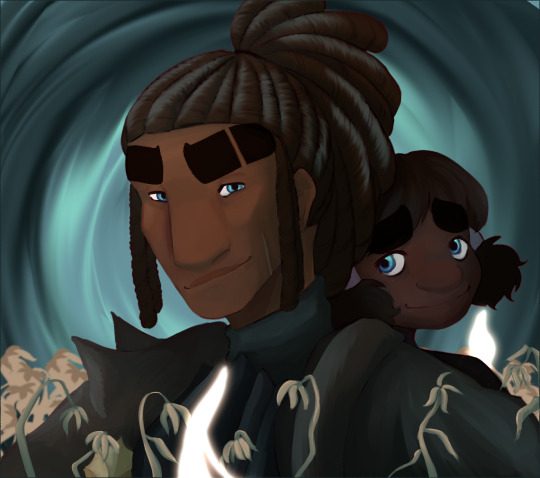

Of nooblooms, of moonglows. Of dried suns and blue blooms. You're a bouquet - petals a gift left pressed on others souls.
#dragon's dogma 2#dd2#doodles#fe'gahl#pawngira#arisen odessa#dd2 odessa#i love you evniromental worldbuilding via indigenous plants#its like monster watching it makes me go ough like the thought! its fun!#like how certain animals exist and dont! like how ox are used in places of horses because horses (i think) dont exist!!#also yknow. character symbolism#teehee#will i ever stop doing the sad thing with the arisen odessa duo? no i dont think i will
22 notes
·
View notes
Text
I’m reading Robin Wall Kimmerer’s Braiding Sweetgrass at the moment and wow, I’ve cried every chapter so far. The way she nurtures her deep generational pain and turns it into love and wisdom is just awe-inspiring. A lesson we could all learn from
#braiding sweetgrass#hopepunk#solarpunk#environmentalism#social justice#cottagepunk#climate justice#bright future#community#optimism#robin wall kimmerer#indigenous wisdom#plant medicine#potawatomi#the honourable harvest#wiingaashk
189 notes
·
View notes
Text
In the Willamette Valley of Oregon, the long study of a butterfly once thought extinct has led to a chain reaction of conservation in a long-cultivated region.
The conservation work, along with helping other species, has been so successful that the Fender’s blue butterfly is slated to be downlisted from Endangered to Threatened on the Endangered Species List—only the second time an insect has made such a recovery.
[Note: "the second time" is as of the article publication in November 2022.]
To live out its nectar-drinking existence in the upland prairie ecosystem in northwest Oregon, Fender’s blue relies on the help of other species, including humans, but also ants, and a particular species of lupine.
After Fender’s blue was rediscovered in the 1980s, 50 years after being declared extinct, scientists realized that the net had to be cast wide to ensure its continued survival; work which is now restoring these upland ecosystems to their pre-colonial state, welcoming indigenous knowledge back onto the land, and spreading the Kincaid lupine around the Willamette Valley.
First collected in 1929 [more like "first formally documented by Western scientists"], Fender’s blue disappeared for decades. By the time it was rediscovered only 3,400 or so were estimated to exist, while much of the Willamette Valley that was its home had been turned over to farming on the lowland prairie, and grazing on the slopes and buttes.
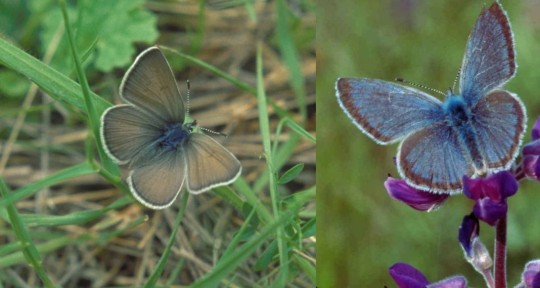
Pictured: Female and male Fender’s blue butterflies.
Now its numbers have quadrupled, largely due to a recovery plan enacted by the Fish and Wildlife Service that targeted the revival at scale of Kincaid’s lupine, a perennial flower of equal rarity. Grown en-masse by inmates of correctional facility programs that teach green-thumb skills for when they rejoin society, these finicky flowers have also exploded in numbers.
[Note: Okay, I looked it up, and this is NOT a new kind of shitty greenwashing prison labor. This is in partnership with the Sustainability in Prisons Project, which honestly sounds like pretty good/genuine organization/program to me. These programs specifically offer incarcerated people college credits and professional training/certifications, and many of the courses are written and/or taught by incarcerated individuals, in addition to the substantial mental health benefits (see x, x, x) associated with contact with nature.]
The lupines needed the kind of upland prairie that’s now hard to find in the valley where they once flourished because of the native Kalapuya people’s regular cultural burning of the meadows.
While it sounds counterintuitive to burn a meadow to increase numbers of flowers and butterflies, grasses and forbs [a.k.a. herbs] become too dense in the absence of such disturbances, while their fine soil building eventually creates ideal terrain for woody shrubs, trees, and thus the end of the grassland altogether.
Fender’s blue caterpillars produce a little bit of nectar, which nearby ants eat. This has led over evolutionary time to a co-dependent relationship, where the ants actively protect the caterpillars. High grasses and woody shrubs however prevent the ants from finding the caterpillars, who are then preyed on by other insects.
Now the Confederated Tribes of Grand Ronde are being welcomed back onto these prairie landscapes to apply their [traditional burning practices], after the FWS discovered that actively managing the grasslands by removing invasive species and keeping the grass short allowed the lupines to flourish.
By restoring the lupines with sweat and fire, the butterflies have returned. There are now more than 10,000 found on the buttes of the Willamette Valley."
-via Good News Network, November 28, 2022
#butterflies#butterfly#endangered species#conservation#ecosystem restoration#ecosystem#ecology#environment#older news but still v relevant!#fire#fire ecology#indigenous#traditional knowledge#indigenous knowledge#lupine#wild flowers#plants#botany#lepidoptera#lepidopterology#entomology#insects#good news#hope
4K notes
·
View notes
Text
Some things I’ve been thinking about. At times being an American trad witch is incredibly frustrating and at others it’s absolutely exhilarating, rewarding. Reconnecting with my ancestral ( primarily french and scottish ) lore, magical practices, witchcraft etc has and will continue to inform my practice but I’ll never be a “french” witch. I’ll never be a “scottish” witch. I can find a lone hawthorn or a sacred tree guarding a hidden spring to tie the cloutie to, I can divine via a snail’s mucus trail, Fly to the Sabbath to meet The Abbess, heed the Dame Blanches, pluck the golden bloom with songs to St Columba, safeguard me and mine via silver, spring water and juniper. Yet there’s many things I’ll never know or be able to do. Whether that’s because these things are so tied to the land or a specific place, language barriers, ( working to overcome this one ) or due to the ( well warranted) gate keeping of lore and practices.
This used to be a source of great confusion for me. I think because I was afraid( due to my previous new age fuckwittery ) to experiment, do anything other than what I understood as “traditional”. My understanding being too rigid at the time; the pendulum swung from one end of the spectrum to the other. This delayed my progress and “froze” me. I was left wondering what an “American” trad craft would look like; most our books do come from a European POV. Learning of our own magical traditions as well as those of my Canadian family ( still working on that one haha ) helped. Reading Robin Kimmere helped. Reading Schulke, him being an American and writing on American plants, helped too. I’ve come to know Sugar Maple and Plantain as powerful spirits. Both teaching important lessons on how to rectify my ancestors mistakes, to foster relations with the First Peoples and how to incorporate the magic of this land into my craft. Rather than being frustrated by my being American I see it as a challenge now. I get to explore spirits, plants, places, animals, spiritual/physical ecologies ( is even really a difference between these?) completely unknown to my ancestors. I get to reconcile the old and the new. To learn from Spirit Direct. Tradition isn’t the worship of ashes, it’s the preservation of Fire. New wood must be added to keep The Fire burning. The Devil of this land certainly is a spirit of the unknown.
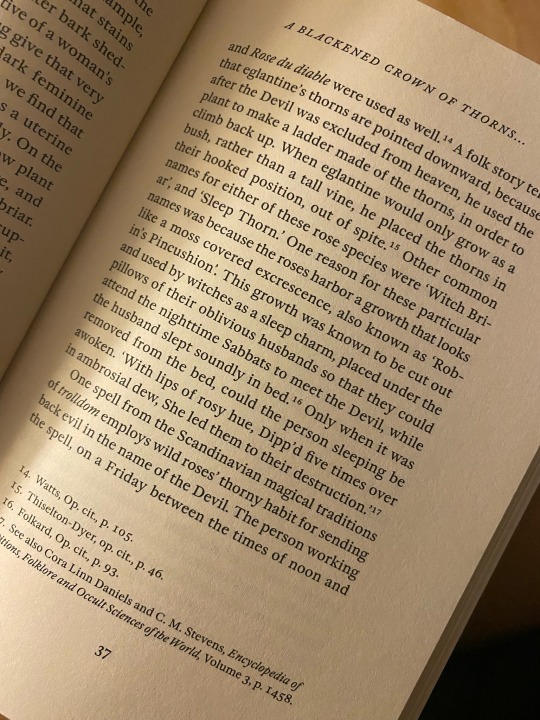
I am the land, the land is me.
I don’t own it, to it I owe all.
To it my body will return, the tithe paid.
I’m not rolling hills of heather, white chalk cliffs, the monk’s island nor the azure coast. The memories of these places echo distantly in my blood, sung alive by my ancestors shades. Part of me they’ll always be; yet it’s not who I am. Not what I am.
I’m craggy shores, dull-jade waves bearing down upon the tired rocks. I am musky pine forests veiled in mist. Sun-venerating oaks hugging the shoreline. Bleeding alders in damp ground swelling. Proud maples sustaining generation upon generation with their boiled blood. Death-grey clay, exposed by running spring.
I am the kudzu, the itching moth, the knotweed, the Norway maple, the ivy wrecking havoc upon the land. My surname and light skin proof of a genocide ongoing. I am my ancestors sins; the specter of the Old Growth forests, their grief hanging over the land like a fog. Every interaction with The Land tinged with sadness, loss.
I am my maternal side’s copper curls. Melusine’s pride. Ave Landry! Ave Gauthier! Forebears mine.
I am my paternal side’s grief. The end result of decades of cultural warfare. The Jesuits stole our name….my hair will not be cut.
Never will I libate these glacier carved valleys with booze.
I am the plantain, learning a kinder way. The sumac reclaiming the orchard.
My Februarys, my Marches aren’t snow drops and daffodils peaking through the frozen ground. They’re steely skies and walls of sleet. Bloodroot heralds winters wane; not Brigid’s flower.
My June isn’t fields of poppies, it’s seas of crimson staghorn blooms skyward reaching.
My augusts aren’t golden shafts of wheat, swaying in summer’s last breaths; they’re explosions of neon-violet and honey-yellow. Corn ripening on the vine, supporting the climbing bean. The cicadas song reverberating.
Old Michaelmas marks harvest’s end, October potatoes long buried in soils darkness finally exhumed. The Devil his Rosy Briar to ascend and plunge.
With Novembers first snows the Dead come in.
I’ll never process around a standing stone nor know what it is to live and eat off the land my dead lay in. Finally, I’m learning to be at peace with this. To love and know the land I live on. I’ll always be a stranger here, a guest. I hope to be a good one.
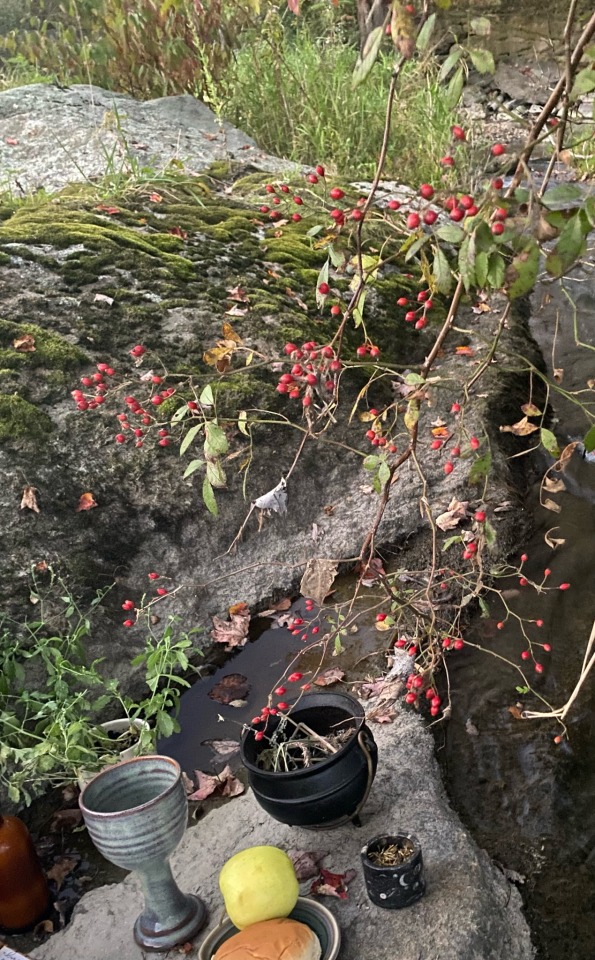
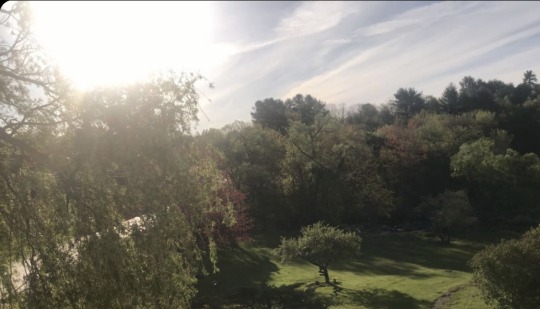
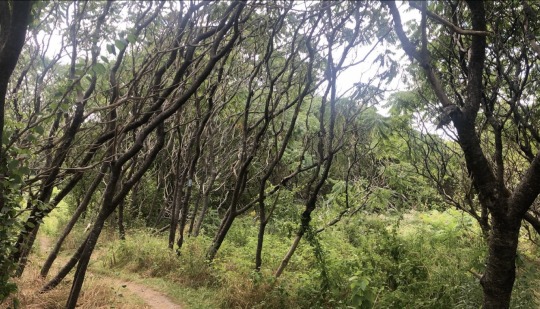
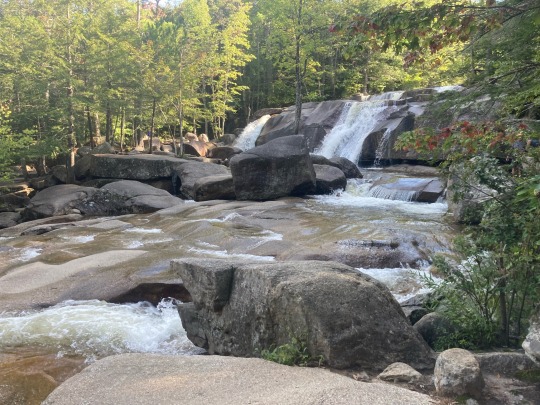
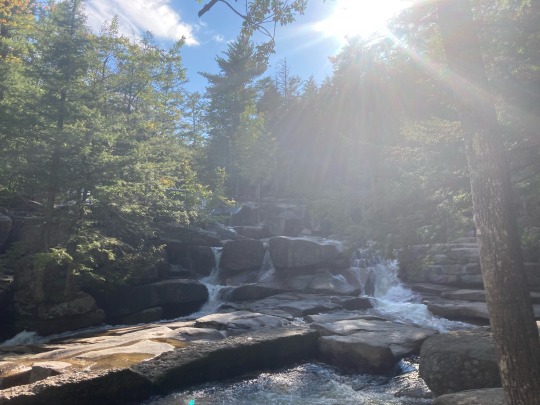
#folk magic#tradcraft#traditional witchcraft#witch#folklore#magic#magick#traditional craft#witchcraft#occult#animism#animist#animistic#animists#witches#indigenous#reparations#Michaelmas#native plants#invasive plants#ancesters#ancestry#ancestral veneration#American witch#American witchcraft#Daniel schulke#traditional American witchcraft#American traditional witchcraft#Corrine Boyer#poetry
107 notes
·
View notes
Text
Good News - August 15-21
Like these weekly compilations? Tip me at $kaybarr1735 or check out my new(ly repurposed) Patreon!
1. Smart hives and dancing robot bees could boost sustainable beekeeping
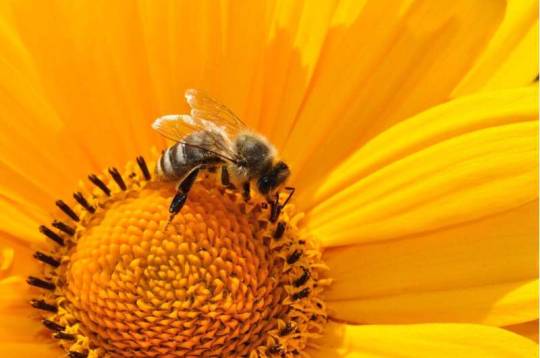
“[Researchers] developed a digital comb—a thin circuit board equipped with various sensors around which bees build their combs. Several of these in each hive can then transmit data to researchers, providing real-time monitoring. [… Digital comb] can [also] be activated to heat up certain parts of a beehive […] to keep the bees warm during the winter[…. N]ot only have [honeybee] colonies reacted positively, but swarm intelligence responds to the temperature changes by reducing the bees' own heat production, helping them save energy.”
2. Babirusa pigs born at London Zoo for first time

“Thanks to their gnarly tusks […] and hairless bodies, the pigs are often called "rat pigs" or "demon pigs” in their native Indonesia[….] “[The piglets] are already looking really strong and have so much energy - scampering around their home and chasing each other - it’s a joy to watch. They’re quite easy to tell apart thanks to their individual hair styles - one has a head of fuzzy red hair, while its sibling has a tuft of dark brown hair.””
3. 6,000 sheep will soon be grazing on 10,000 acres of Texas solar fields

“The animals are more efficient than lawn mowers, since they can get into the nooks and crannies under panel arrays[….] Mowing is also more likely to kick up rocks or other debris, damaging panels that then must be repaired, adding to costs. Agrivoltaics projects involving sheep have been shown to improve the quality of the soil, since their manure is a natural fertilizer. […] Using sheep instead of mowers also cuts down on fossil fuel use, while allowing native plants to mature and bloom.”
4. Florida is building the world's largest environmental restoration project

“Florida is embarking on an ambitious ecological restoration project in the Everglades: building a reservoir large enough to secure the state's water supply. […] As well as protecting the drinking water of South Floridians, the reservoir is also intended to dramatically reduce the algae-causing discharges that have previously shut down beaches and caused mass fish die-offs.”
5. The Right to Repair Movement Continues to Accelerate

“Consumers can now demand that manufacturers repair products [including mobile phones….] The liability period for product defects is extended by 12 months after repair, incentivising repairs over replacements. [… M]anufacturers may need to redesign products for easier disassembly, repair, and durability. This could include adopting modular designs, standardizing parts, and developing diagnostic tools for assessing the health of a particular product. In the long run, this could ultimately bring down both manufacturing and repair costs.”
6. Federal Judge Rules Trans Teen Can Play Soccer Just In Time For Her To Attend First Practice
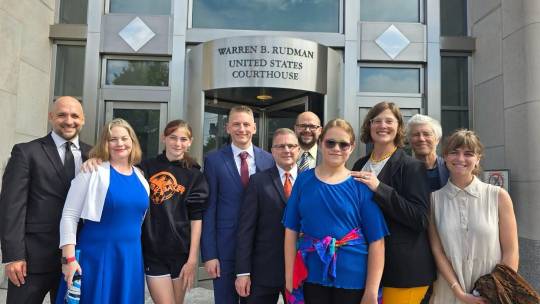
“Today, standing in front of a courtroom, attorneys for Parker Tirrell and Iris Turmelle, two transgender girls, won an emergency temporary restraining order allowing Tirrell to continue playing soccer with her friends. […] Tirrell joined her soccer team last year and received full support from her teammates, who, according to the filing, are her biggest source of emotional support and acceptance.”
7. Pilot study uses recycled glass to grow plants for salsa ingredients

“"We're trying to reduce landfill waste at the same time as growing edible vegetables," says Andrea Quezada, a chemistry graduate student[….] Early results suggest that the plants grown in recyclable glass have faster growth rates and retain more water compared to those grown in 100% traditional soil. [… T]he pots that included any amount of recyclable glass [also] didn't have any fungal growth.”
8. Feds announce funding push for ropeless fishing gear that spares rare whales

“Federal fishing managers are promoting the use of ropeless gear in the lobster and crab fishing industries because of the plight of North Atlantic right whales. […] Lobster fishing is typically performed with traps on the ocean bottom that are connected to the surface via a vertical line. In ropeless fishing methods, fishermen use systems such an inflatable lift bag that brings the trap to the surface.”
9. Solar farms can benefit nature and boost biodiversity. Here’s how

“[… M]anaging solar farms as wildflower meadows can benefit bumblebee foraging and nesting, while larger solar farms can increase pollinator densities in surrounding landscapes[….] Solar farms have been found to boost the diversity and abundance of certain plants, invertebrates and birds, compared to that on farmland, if solar panels are integrated with vegetation, even in urban areas.”
10. National Wildlife Federation Forms Tribal Advisory Council to Guide Conservation Initiatives, Partnerships
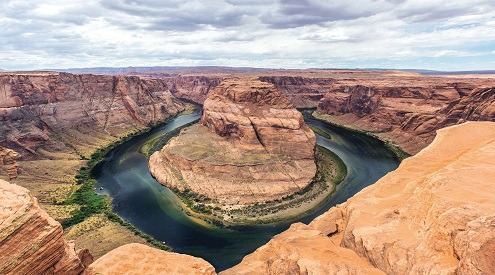
“The council will provide expertise and consultation related to respecting Indigenous Knowledges; wildlife and natural resources; Indian law and policy; Free, Prior and Informed Consent[… as well as] help ensure the Federation’s actions honor and respect the experiences and sovereignty of Indigenous partners.”
August 8-14 news here | (all credit for images and written material can be found at the source linked; I don’t claim credit for anything but curating.)
#hopepunk#good news#honeybee#bees#technology#beekeeping#piglet#london#zoo#sheep#solar panels#solar energy#solar power#solar#florida#everglades#water#right to repair#planned obsolescence#trans rights#trans#soccer#football#recycling#plants#gardening#fishing#whales#indigenous#wildlife
136 notes
·
View notes
Text

The tasty tomatillo (Physalis philadelphica) is where we get the English name “tomato”. The tomatillo is a domesticated version of wild plants found in Central America and is known in the Nahuatl language as “tomatl”. This plant is related to tomatoes because it is a member of the Solanaceae family, but it is not a tomato! This fruit grows in a husk that resembles a paper lantern and when it’s ripe the husk splits to reveal the plump green fruit. The tomatillo is the main ingredient of Mexican / Tex Mex salsa verde.
#katia plant scientist#botany#plant biology#plant science#plants#tomatillos#tomato#green#plant scientist#plant#plant aesthetic#plantblr#plantcore#greenhouse#edible plants#nahuatl#mexican food#aztecs#indigenous food#salsa verde#fruit#exotic fruit#gardening
83 notes
·
View notes
Text
I grew corn this year yall!

Look at how beautiful it is!
it is so super colorful and yes I know it is itty bitty, but this is my first attempt ever at growing corn so I am excited I even did it right!

I also grew cherry tomatoes

These heirloom glass gem corn seeds were a gift from the local market here to promote Indigenous education and revitalization of our ancient ways, and of course we followed our ancestral 3 sisters growing style but the squash bugs murdered my pumpkin plants😤My rattlesnake beans did make it but I ate them before I did a photoshoot 😅
#farm and garden#gardening#fall harvested#corn#heirloom seeds#indigenous knowledge#indigenous ways#plant witch#green thumb#my photography
14 notes
·
View notes
Text
youtube
Healing Forest, SUGi’s first short film, tells the story of an unprecedented collaboration between SUGi and the Yakama Nation community. This short film brings the forest's remarkable growth and nourishing power to life.
As you watch the film, you enter the forest and become part of a movement to partner with Tribal communities to weave a renewed sense of healing and possibility across the First Nations of the United States.
SUGi Forest Makers:
Ethan Bryson @naturalurbanforests & MaryLee Smunitee Jones @smunitee
Director: Brad Abrams
DOP: Brad Abrahams, Cody Cobb & Ryan McMackin
Photography: Cody Cobb, Stephanie Hsie & Ryan McMackin
Production Assistant: Adam Whitley
Editor: Camille Durand
Produced: SUGi
Titles: SUGi
Forests Partners: Breitling, Tiger Global Impact Ventures, Life_Time_Foundation, AllBirds x Voice for Nature
iDig2Learn x ROIC x The Lenape People
Special thanks to: Joelle Jones, Chief Vernon Alvarez and the The Yakama Nation
Everyone who has contributed to the planting, the film, the drawing class & the swan dances. Thank you for joining us in healing the soil.
#SUGi#solarpunk#USA#indigenous peoples#first nations#Yakama Nation#Miyawaki forests#reforestation#native plants#indigenous plants#Youtube
8 notes
·
View notes